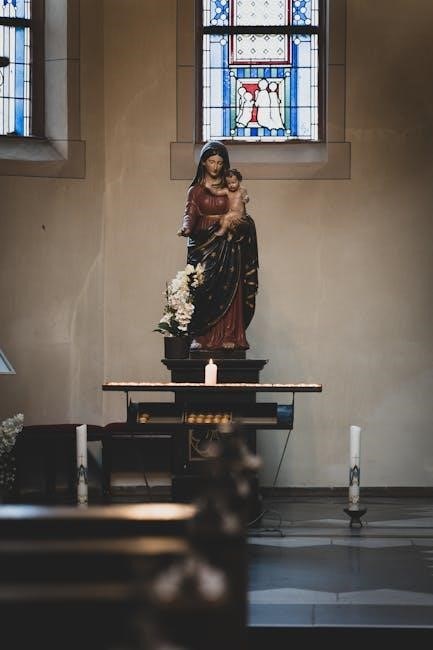Lectio Divina, or “divine reading,” is a Catholic spiritual practice rooted in monastic traditions, emphasizing prayerful engagement with Scripture. It fosters a deeper connection with God’s Word, nurturing faith and contemplation through reflective reading and meditation.
Definition and Historical Context
Lectio Divina, meaning “divine reading” in Latin, is a Catholic spiritual practice rooted in the monastic traditions of early Christianity. It involves a prayerful, contemplative approach to reading Scripture, aiming to encounter God’s presence in the Word. Originating in the Desert Fathers and Mothers, this method was formalized in the Middle Ages by monastic communities. The practice emphasizes a gradual progression from literal understanding to spiritual transformation, fostering a personal encounter with God. Historically, Lectio Divina was a cornerstone of monastic life, guiding monks in their meditation and prayer. Over centuries, it has evolved into a accessible practice for all Catholics, offering a profound way to engage with sacred texts. Its enduring relevance lies in its ability to deepen faith, nurture contemplation, and inspire a heartfelt response to God’s revelation.

Significance in Catholic Spirituality
Lectio Divina holds profound significance in Catholic spirituality as a practice that deepens one’s relationship with God through Scripture. It is a powerful method for spiritual growth, fostering a personal encounter with the divine. By engaging with the Word of God in a prayerful and contemplative manner, Catholics are able to discern God’s will and apply its teachings to their daily lives. This practice is particularly valued for its ability to nurture faith, inspire hope, and guide believers in living out their Christian vocation. Lectio Divina also serves as a means of revitalizing one’s spiritual life, offering fresh insights and a deeper understanding of God’s love. Its emphasis on contemplation aligns with the Catholic tradition of seeking a balanced life of prayer and action. As a timeless spiritual tool, Lectio Divina continues to enrich the faith journey of countless Catholics, helping them grow in holiness and intimacy with Christ.

The Four Steps of Lectio Divina

Lectio Divina involves four transformative steps: reading (lectio), meditation (meditatio), prayer (oratio), and contemplation (contemplatio). These steps guide Catholics in prayerfully engaging with Scripture, deepening their connection to God’s Word and divine truth.
Step 1: Reading (Lectio)
The first step of Lectio Divina is Lectio, or reading. This involves slowly and attentively reading a selected Scripture passage, often aloud, to engage both the mind and heart. The goal is not to analyze but to listen for the Word of God. Catholics are encouraged to choose a text, such as a Gospel story or a passage from the Old Testament, and read it carefully, allowing the words to sink deeply. This step sets the foundation for the spiritual journey, inviting the Holy Spirit to illuminate the meaning of the text. By reading with openness and reverence, one prepares to move into reflection and prayer, fostering a deeper encounter with God’s divine message. This initial reading is a call to quiet the spirit and be receptive to God’s voice.
Step 2: Meditation (Meditatio)

Meditatio, or meditation, is the second step of Lectio Divina, where one reflects on the Scripture passage read during Lectio. This step involves pondering the text, allowing it to resonate deeply within the heart and mind. It is a time to ask questions like, “What is God saying to me through this passage?” or “What does this reveal about His love and will?” Catholics are encouraged to focus on specific phrases or words that stand out, seeking to uncover the spiritual meaning and application. Meditation is not about intellectual analysis but rather about listening for God’s voice and allowing the Holy Spirit to illuminate the text. This step bridges the gap between reading and prayer, nurturing a personal connection with the divine message. By dwelling on the Scripture, one prepares to move into heartfelt conversation with God in the next step, Oratio. Meditation fosters a deeper understanding and appreciation of God’s Word, making it relevant to daily life.
Step 3: Prayer (Oratio)
Oratio, or prayer, is the third step of Lectio Divina, where one transitions from meditation to a heartfelt conversation with God. This step involves expressing personal feelings, thanksgiving, or requests inspired by the Scripture passage. It is a spontaneous and sincere dialogue, moving beyond reflection to a direct encounter with the divine. Catholics are encouraged to speak openly to God, using their own words to articulate what the Holy Spirit has stirred in their hearts. This prayer is not about reciting formal prayers but rather about allowing the insights from Meditatio to flow into a personal and intimate exchange with God. Oratio requires humility and openness, trusting that God is present and active in the process. By praying in this way, individuals deepen their relationship with God and allow His Word to guide their thoughts and actions. This step prepares the soul for the final stage of Contemplatio, where one rests in God’s presence. Through Oratio, the Scripture becomes a living prayer, transforming the heart and mind.
Step 4: Contemplation (Contemplatio)
Contemplation, the final step of Lectio Divina, is a sacred moment of resting in God’s presence. It is a silent, receptive state where the soul absorbs the divine truth revealed through Scripture. In this phase, one surrenders to God’s love and wisdom, allowing the Holy Spirit to deepen the connection with the divine. Contemplatio is not about thinking or analyzing but rather about being still and open to God’s grace. It is a gift, often described as a moment of spiritual communion, where the heart is filled with peace and clarity. This step requires patience and openness, as it is a passive reception of God’s presence. Through Contemplation, believers experience a profound sense of unity with God, which can lead to spiritual renewal and a deeper understanding of His will. It is in this final step that the transformative power of Lectio Divina is fully realized, guiding individuals to live in greater harmony with Christ’s teachings. Contemplatio is the culmination of the prayerful journey, where the Word of God becomes a living, breathing reality in the heart.
Resources for Practicing Lectio Divina
Discover Catholic PDF guides and Scripture selections to deepen your Lectio Divina practice. These resources provide structured methods and reflections, helping you engage more meaningfully with God’s Word in a prayerful and contemplative manner.

Recommended Catholic PDF Guides
Several Catholic PDF guides offer comprehensive insights into practicing Lectio Divina, providing structured methods for reflection and prayer. These resources, available from sources like the Catholic Truth Society and the Carmelite tradition, include step-by-step instructions, meditative exercises, and selected Scripture passages. One notable guide, Lectio Divina for Personal Prayer, adapts traditional monastic practices for individual use, encouraging a deeper encounter with God’s Word. Another resource, The Liturgy Office, offers daily readings and reflections aligned with the Church’s liturgical calendar, enhancing the spiritual journey. These guides are designed to assist both beginners and seasoned practitioners in cultivating a prayerful and contemplative approach to Scripture. They emphasize the importance of silence, reflection, and openness to the Holy Spirit, making them invaluable tools for those seeking to enrich their faith life through Lectio Divina.
Scripture Selections for Reflection
Scripture selections are central to the practice of Lectio Divina, offering a foundation for prayerful reflection. Narrative passages, such as the parable of the Prodigal Son (Luke 15:1-3, 11-32), are often recommended for their richness in themes of mercy, forgiveness, and divine love. Gospel stories, like those of Jesus’ interactions with outcasts and sinners, provide vivid imagery for meditation. The Psalms, with their expressive language, are also ideal for contemplation, as they capture a wide range of human emotions and spiritual experiences. Additionally, daily readings from the Church’s liturgical cycle, available through resources like the United States Conference of Catholic Bishops, offer a structured approach to reflection. These selections invite participants to engage deeply with God’s Word, fostering personal growth and a closer encounter with the divine. By focusing on specific passages, individuals can immerse themselves in the sacred text, allowing its message to resonate in their hearts and lives.

